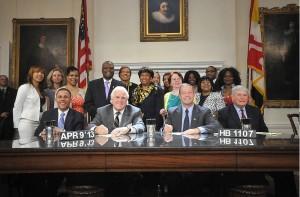Table games come to Maryland Live! this Thursday, County Executive Baker school takeover goes from theory to reality June 1st, O’Malley signs legislation expanding wind energy to Ocean City offshore at what cost?
According to the November 2012 ballot results, I’m wrong about gambling and the 67% taxable income Maryland casinos generate will solve a host of our funding woes. The entire state of Maryland brought in $58 million in revenues from casinos in March 2013. Of that, $44.6 million was generated by Maryland Live! So I guess you can say poo-poo to my belief that relying on gambling for revenue is like relying on crack for kicks and giggles.


Gov. O’Malley, D-Md., signed into law on Tuesday the Maryland Offshore Wind Energy Act of 2013, legislation meant to create a framework for the development of wind energy off the state’s coast. From North American Windpower, “Passed by the Maryland House of Delegates in February and the state Senate in March, the legislation aims to provide up to $1.7 billion to subsidize the construction of a 200 MW offshore wind farm. If such a wind farm is proposed, permitted and constructed, the act would allow Maryland utility customers to be charged $1.50 a month on their electricity bills to help offset the project costs.
In addition, the legislation alters Maryland’s 20% by 2020 renewable portfolio standard, requiring the state’s utilities to begin obtaining 2.5% of their electricity from offshore wind by 2017 if such a project is built. According to the governor’s office, a 200 MW offshore wind farm would support about 850 manufacturing and construction jobs and 160 more supply and operations and maintenance jobs afterwards. O’Malley introduced the Maryland Offshore Wind Energy Act of 2013 in January, his third attempt at establishing offshore wind legislation. His 2011 and 2012 versions of the act were defeated by the Maryland General Assembly.”

outgoing current Chair of the School Board is quoted as saying “We’ve always said that we want to move forward and remain child-focused”…HAHAHAHAHAHAHAAAAA!!! That gulping sound you just heard is the crow she’s having to swallow. At this point, we all better just act as a collective oversight committee and make chime in about everything we can. I believe Baker’s motives are in the right place; he doesn’t mean the education system harm. It’s just that the last person he appointed as Superintendent ended up in jail.
Here’s the Gazette’s breakdown of the legislation, which is pretty clear:
House Bill 1107 makes the following changes to the school system structure:
- Adds four appointed members to the board of nine elected and one student member.
- One appointed by the county executive with education experience;
- One appointed by the county executive with business or higher education experience;
- One appointed by the county executive with management experience;
- One appointed by the County Council who is a parent with a child currently in the school system.
- Gives the county executive the power to appoint the board chair and vice chair, with two-year terms.
- Vice chair must be an elected board member.
- All appointments must be completed on or before June 1.
- Authorizes the county executive to appoint replacements to any vacant board positions.
- Creates a superintendent search committee composed of three individuals:
- One member of the State Board of Education, appointed by the State Superintendent;
- Two county residents, appointed by the governor.
- Requires this committee to reopen the superintendent search and present a list of three candidates to the county executive.
- The county executive selects the superintendent, who is then appointed by the school board following contract negotiations with the chair. (Search may extend into the next fiscal year this time only)
- Defines the superintendent’s role as manager of day-to-day operations of school system and budget, hiring and setting salaries for executive staff.
- Under most circumstances, requires a two-thirds’ vote of the board to reverse decisions by the superintendent.
- Leaves oversight of the budget in the hands of the school board.
- Defines the board’s primary responsibilities as improving student achievement and increasing parental engagement.
- Directs the superintendent to enter into agreements with the University of Maryland College Park, University of Maryland University College, Bowie State University, Prince George’s Community College and any other higher education institutions he/she chooses for purpose of providing policy advice and analysis to school board and superintendent
- Comes up for review before the General Assembly in the 2018 legislative session.
